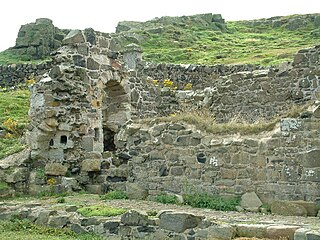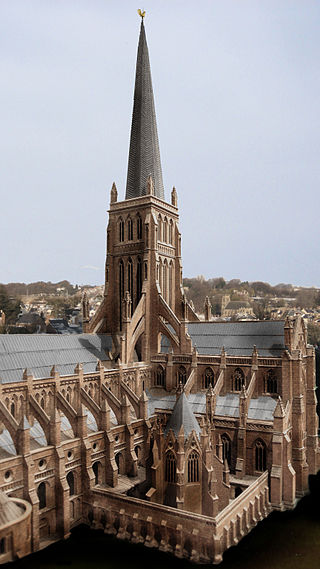
Andrew Forman was a Scottish diplomat and prelate who became Bishop of Moray in 1501, Archbishop of Bourges in France, in 1513, Archbishop of St Andrews in 1514 as well as being Commendator of several monasteries.
The Abbot of Paisley was the head of the Cluniac monastic community of Paisley Abbey and its property. The monastery was founded as a priory at Renfrew in 1163, but moved to Paisley in 1169. It became an abbey in 1219. The founder was Walter fitz Alan, Seneschal (Steward) of Scotland. The line of abbots ended when it was turned into a secular lordship for Lord Claud Hamilton in 1587/1592. The following is a list of abbots and commendators:
The Abbot of Kelso was the head of the Tironensian monastic community at Kelso Abbey in the Scottish Borders. The Abbey was originally founded at Selkirk in 1113 by David, Prince of the Cumbrians, and thus the first three Abbots were Abbots of Selkirk. The community was moved to Kelso by David and John, Bishop of Glasgow in 1127. The abbot was the first in Scotland to be granted the mitre in 1165. In the 16th century the monastery increasingly came under secular control, and finally in 1607 it was granted as a secular lordship (Holydean) to its last commendator, Robert Ker of Cesford, later Earl of Roxburghe. The following is a list of abbots and commendators:

The Prior, then Abbot and then Commendator of Dunfermline was the head of the Benedictine monastic community of Dunfermline Abbey, Fife, Scotland. The abbey itself was founded in 1128 by King David I of Scotland, but was of earlier origin. King Máel Coluim mac Donnchada had founded a church there with the help of Benedictines from Canterbury. Monks had been sent there in the reign of Étgar mac Maíl Choluim and Anselm had sent a letter requesting that Étgar's brother and successor King Alaxandair mac Maíl Coluim protect these monks. By 1120, when Alaxandair sent a delegation to Canterbury to secure Eadmer for the bishopric of St Andrews, there is a Prior of the Dunfermline monks by the name of Peter leading the delegation. Control of the abbey was secularized in the 16th century and after the accession of James Stewart in 1500, the abbey was held by commendators. In the second half of the 16th century, the abbey's lands were being carved up into lordships and it was finally annexed to the crown in July, 1593.

The Abbot of Scone, before 1163 x 4, Prior of Scone, and then by the beginning of the 16th century, the Commendator of Scone, was the head of the community of Augustinian canons of Scone Abbey and their lands. The priory was established by King Alaxandair mac Maíl Choluim sometime between 1114 and 1120, and was elevated to the status of an abbey in 1163 or 1164. The abbey was turned into a secular lordship for William Ruthven, 1st Earl of Gowrie in 1581, but was forfeited when the earl was executed in 1584, given to William Foularton in the same year, but restored to the earl's son, James Ruthven, 2nd Earl of Gowrie. An independent secular lordship was established for David Murray in 1608.
The Prior of St Andrews was the head of the property and community of Augustinian canons of St Andrews Cathedral Priory, St Andrews, Fife, Scotland. It was established by King David I in 1140 with canons from Nostell Priory, West Yorkshire. It is possible that, initially at least, the prior of St Andrews was subordinate to the bishop as abbot, but by the 13th century the canons of St Andrews were given freedom by the bishop to elect their prior. By the end of the 13th century, the abbacy of the native canons was no longer there to challenge the position of the priory, and the native canons themselves had been formed into a collegiate church.
St Andrews Cathedral Priory was a priory of Augustinian canons in St Andrews, Fife, Scotland. It was one of the great religious houses in Scotland, and instrumental in the founding of the University of St Andrews.
The Prior of Whithorn was the head of the monastic community at Whithorn Priory, attached to the bishopric of Galloway at Whithorn. It was originally an Augustinian establishment, but became Premonstratensian by the time of the second or third known prior. As most of the priors of Whithorn appear to be native Galwegian Gaels, it would appear that most priors before the 16th century at least were drawn from region, something unusual in medieval Scotland. The following is a list of abbots and commendators.
The Abbot of Balmerino was the head of the Cistercian monastic community and lands of Balmerino Abbey, Fife, founded in 1227 x 1229 by monks from Melrose Abbey with the patronage of Ermengarde de Beaumont and King Alexander II of Scotland. The following are a list of abbots and commendators.
The Prior of Inchmahome was the head of the community of Augustinian canons at Inchmahome Priory, on Inchmahome in the Lake of Menteith, in Highland Stirlingshire, Scotland. The following is a list of priors and commendators:
The Prior of Restenneth was the head of the Augustinian canons of Restenneth Priory, Angus. The following is a list of priors and commendators:
The Prior of Urquhart was the head of the Benedictine monastic community of Urquhart Priory in Moray. The Priory of Urquhart was merged with the Priory of Pluscarden in 1454. The following is a list of priors and commendators: ___NOTOC___
The Abbot of Newbattle was the head of the Cistercian monastic community of Newbattle Abbey, Midlothian. It was founded by David I of Scotland in 1140.
The Prior of Blantyre was the head of the medieval community of Augustinian canons based at Blantyre Priory. It was founded between 1239 and 1248, but the first prior is not known by name until 1296. Few of the priors are known thereafter until records become more extensive in the 16th century. The following is a list of known priors and commendators:

The Isle of May Priory was a monastery and community of Benedictine monks established for 9 monks of Reading Abbey on the Isle of May in the Firth of Forth, Scotland, in 1153, under the patronage of David I of Scotland. The priory passed into the control of St Andrews Cathedral Priory in the later 13th century, and in 1318 the community relocated to Pittenweem Priory on the Fife coast.
The Archdeacon of Teviotdale was the head of the Archdeaconry of Teviotdale, a sub-division of the Diocese of Glasgow. He was one of two archdeacons serving the Bishop of Glasgow. As the name describes, this archdeacon was responsible for the Teviotdale region of the Scottish Borders region. The position was an important position within the medieval Scottish church; because of the high number of parish churches in the archdeaconry.
The Archdeacon of Dunkeld was the only archdeacon in the Diocese of Dunkeld, acting as a deputy of the Bishop of Dunkeld. The following is a list of archdeacons:
The Prior of Coldingham was the head of the Benedictine monastic community of Coldingham Priory in Berwickshire, Scotland. The priory was founded in the reign of David I of Scotland, although his older brother and predecessor King Edgar of Scotland had granted the land of Coldingham to the Church of Durham in 1098 AD, and a church was constructed by him and presented in 1100. The first prior is on record by the year 1147, although an earlier foundation is almost certain. The monastic cell was a dependent of Durham until the 1370s, and in 1378 King Robert II of Scotland expelled the Durham monks; for the following century the cell had two priors, one chosen by Durham and one chosen by the Scots. It became a dependent of Dunfermline Abbey. It was subject to increasingly secular control from the late 15th century into the 16th century.
The Prior of Perth was the head of Perth Charterhouse, the Carthusian monastic house located near Perth. It was founded in 1429, and finally suppressed in 1602. The following is a list of priors and prior-commendators:

The Dean and Chapter of St Paul's Cathedral was the titular corporate body of St Paul's Cathedral in London up to the end of the twentieth century. It consisted of the dean and the canons, priests attached to the cathedral who were known as "prebendaries" because of the source of their income. The Dean and Chapter was made up of a large number of priests who would meet "in chapter", but such meetings were infrequent and the actual governance was done by the Administrative Chapter headed by the dean, made up of several senior "residentiary canons", who were also known as the "Dean and Canons of St Paul’s" or simply "The Chapter".




